Buyer's Guide - Entry Level, January 2005
by Jarred Walton on January 9, 2005 12:05 AM EST- Posted in
- Guides
Small Form Factor Considerations
One of the options that we didn't mention earlier was the possibility of a Small Form Factor (SFF) case. While normally that would add quite a bit to the price, there are a few options that offer very competitive prices and some people will prefer them to purchasing a separate case, motherboard, and/or power supply. Considering that the systems we've put together so far cost roughly $150 for the motherboard and case/PSU, that's our target price for a SFF case. We're willing to go as high as $200, however, as the reduced size may be desirable for a lot of people. There are a decent number of cases that fit that requirement, but we will limit ourselves to the ASUS, BIOSTAR, EPoX, Shuttle, and Soltek offerings for now. (We're still working on the full SFF roundup, in case you were wondering.) Due to pricing concerns, most of our selections will be from the socket 478 and socket A platforms. 754 and 775 are available, but they tend to cost too much for a budget system.  |
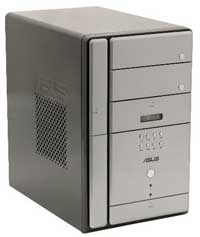 |
| Click images to enlarge. | |
Socket 478 SFF Alternative: ASUS Terminator T2-P or T2-P Deluxe
Price: $137 or $162/$220 shipped
Providing one of the best values for a SFF system, the ASUS T2 line includes a ton of features. Integrated graphics come standard via the 865G chipset, or if you want to look at the T2-R, you could get the ATI 9100IGP graphics - as we mentioned in the motherboard section, the ATI 9100IGP provides better graphics support, but worse overall CPU performance. Sound and networking are standard fare, along with two DIMM slots. The Deluxe model adds in 802.11B WLAN, a gigabit Ethernet (GbE) connection, firewire, a flash card reader, and a radio tuner, along with an enhanced front panel with controls for the radio and CD functions. Both models include a floppy drive.
The case looks good and runs reasonably quiet, but there are a few drawbacks. First, the hinged front covers look nice, but they feel very flimsy; they're not spring loaded, and they're made of cheap plastic. If you don't handle your computer with care, it would be relatively easy to break off some of the plastic "doors". Another problem is that the Deluxe model is available in two versions, so you'll have to make sure that you get the right one. The cheaper version does not include the wireless networking, firewire, GbE, or a CD drive while the "commercial" version adds these extras. The power supply is only rated at 200W, so running a high-end graphics card like a 6800GT or X800 Pro could prove troublesome, but we can attest that the 9800 Pro/XT work without problems. Finally, the case is not a truly small SFF design - it's really about half the size of a standard mini-tower and 50% larger than most other SFF cases. Still, it's not a bad value overall, regardless of which model you choose.
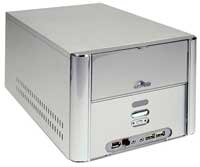 |
 |
| Click images to enlarge. | |
Socket A SFF Alternative: BioStar iDEQ 210VB or 200N
Price: $172 or $207 shipped
For socket A from BioStar, we have two options that meat our criteria. The cheaper option is the 210VB, which uses the VIA KM400A chipset and includes the UniChrome integrated graphics. It also includes firewire, USB, SATA, audio, and 10/100 Ethernet. The more expensive 200N is the preferred version, not only because it uses the superior Nforce2 chipset with MCP-T, but also because it includes two VGA ports powered by a GeForce 4MX core and we prefer the silver aluminum case to the black one. Otherwise, they are very similar in design and features. Again, high-powered graphics cards might push the capabilities of the included 200W PSU, but then a high-powered graphics card would be overkill for an aging Athlon XP/Sempron system. Note that this motherboard supports a maximum bus speed of 333 MHz, so the 400 MHz bus Athlon XP 3000+ and 3200+ are not an option. Given their price, however, we don't think that many people would really consider them anyway.
Socket A SFF Alternative: EPoX Mini Me EP-EX5300NR
Price: $221 shipped
Socket 478 SFF Alternative: EPoX Mini Me EX5-300S
Price: $192shipped
These two cases look very similar internally and externally, but there are a few major differences. First is the CPU socket type, of course, which dictates many of the features. The socket A model also includes a remote control and 250W PSU (instead of a 200W), but it lacks support for SATA - that's important, considering our hard drive recommendations; get a Seagate or Samsung IDE drive instead if you choose the EX5300NR system. Beyond that, features are similar to what other cases offer: firewire, audio, LAN, USB and integrated graphics - the Nforce2 IGP's GF4MX for the AMD system and the 865G's Extreme Graphics 2 on the Intel platform. Both models do not support a floppy drive, although they also come with a flash card reader in the 3.5" bay. On the bottom of the front face is a moderately large display that can be configured to show system parameters; some may like it, and others may find it distracting, as it does tend to be a little bright at face level. Similar to the BioStar cases, only 266 and 333 FSB Athlon XP/Sempron are supported on the socket A model.
Finally, a word of caution: this is a case that may be too small for its own good, as fitting in a moderate size graphics card can bump into the hard drive, causing it to warp the graphics card slightly. We're not particularly thrilled by that prospect, so we would recommend that users who intend to add a decent graphics card to their system look elsewhere. Given the price, features, and diminutive size - remember that in the SFF world, smaller is generally more expensive - it's a decent option, provided that you keep the above comments in mind.
Socket 754 SFF Alternative: Shuttle XPC SK83G
Price: $207 shipped
As our sole representative of the socket 754 platform, we have the Shuttle SK83G. Shuttle also has a few other moderately-priced offerings that some might find interesting, but they tend to cost more than some of the competitors and offer less in the way of features. For example, the SB65G2 is a decent model that lacks integrated graphics, so a separate graphics card would be required. The SN45GV2 is similar in that it uses the Nforce2 Ultra chipset and requires discrete graphics. On the low end, we have the SB51G that includes integrated graphics, but uses the 865GE chipset instead of the slightly more powerful 865G. None of them are terrible choices, but they also don't have much to set them apart in the budget sector.
Returning to the SK83G, let's look at the features. It is reasonably priced and includes a 240W PSU, integrated UniChrome Pro graphics courtesy of the VIA K8M800 chipset, plus all of the other usual suspects: firewire, USB, SATA (plus RAID), audio and networking. An S-Video connection is supported in addition to the VGA connector, which makes this an interesting option for a Home Theater PC if you're interested. Something that other cases neglect is the inclusion of a cover for the 3.5" external bay, should you decide to forego the floppy drive or use that bay for a second hard drive.
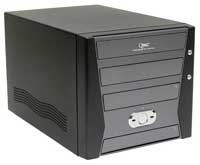 |
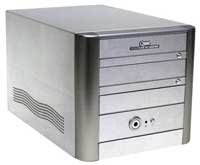 |
| Click images to enlarge. | |
Socket A SFF Alternative: Soltek QBiC EQ3704GD or EQ3705A
Price: $177 or $192 shipped
Wrapping things up with our SFF suggestions, we come to Soltek and their QBiC line. There are several systems that fall into the $200 and below range, but we aren't going to bother with the VIA C3 options, so we're left with the versions based on the KM400A VIA chipset and the NVIDIA Nforce2 IGP. The 3704 is available in several different color schemes, of which we selected the gray/black model. It's a little cheaper than the 3705, but you also lose some performance on the CPU and graphics fronts. In other areas, however, you gain some features: the 3704 includes GbE as well as SATA/RAID, while the 3705 lacks these features. As with the EPoX system, if you are considering the 3705, make sure that you get an IDE drive instead of an SATA drive. It's a personal preference, but we also prefer the look of the aluminum 3705 case. Otherwise, features are the same as the other options: firewire, USB, audio, and network. The Soltek models also include a larger 250W PSU, and you can even fit two optical drives in each case. Using the bottom 5.25" drive bay for a second optical drive will prevent the use most PCI cards, however.


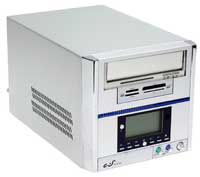
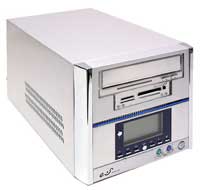
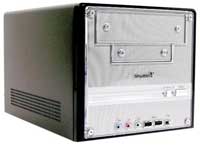








31 Comments
View All Comments
justly - Monday, January 10, 2005 - link
Jarred, Thanks for the responce, and I can certainly understand why you would dislike writing a budget guide.If what you say is true "In a single review with high-end components (which is how we generally handle reviews), a lot of motherboards work very well. When you start dropping down to cheaper RAM, however, it's amazing how frequently system instabilities seem to end up being caused by the motherboard choice." then maybe what is really bothering me is not so much your review but the way motherboard reviews are conducted.
One other thing (just thinking out loud here), how does VIA and SiS chipset affect memory compatibility on a A64 system when the memory controller is part of the CPU??? Do the motherboard manufactures pay more attention to the memory trace lines on Nforce based motherboards (even budget ones) than SiS or VIA based boards??? ... I really think I need an answer to these before I can fully believe you, no offence but I will remain skeptical about your comment to not use VIA or SiS (at least on a A64) untill these are answered.
Maybe you could make a recommendation on how motherboard reviews are conducted, that way Anandtech readers can be informed about these problems that are hidden from us by reviews that only use high-end components.
Thanks again for the reply.
JarredWalton - Monday, January 10, 2005 - link
Good point, PrinceGaz. Of course, my take is that the ability to run the "full" Aero Glass experience mode of Longhorn is essentially a requirement for most people. At the very least, a PC should be upgradeable to that level (with AGP/PCIe cards, not with PCI).18 - I don't actually recommend the FX 5200 as a card for any of the systems. I mentioned it only as the "fastest" PCI graphics card currently available. The 9550 might also be available in PCI version, in which case it would be something of a toss up, but I haven't heard of any ATI DX9 parts for PCI.
#17 - Of course you can get a cheaper system that what I listed. What you've specced out is pretty much the cheapest "modern" system that could be put together. I personally wouldn't recommend that sort of configuration to a friend (or anyone else) without some serious reservations. Basically, it would be a case of "you can get this if you want, but I will not be held responsible for any shortcomings." You basically hit the point of diminishing returns, where $5 to $10 saved ends up costing you 10% of your overall performance (i.e. going from a Sempron 2400+ to a Sempron 2200+), or else you lose certain features that I consider desirable (DVD+RW support).
It's a personal preference, really, so people can go either way. My feeling is that any *new* system should include at bare minimum the following:
512 MB of RAM
80GB Hard Drive w/8MB cache
Sempron 2400+/Celeron D 320
17" monitor
DVD+RW support
You certainly don't *need* any of those features for standard PC use, but I would definitely recommend spending the extra $50 or so to get them.
PrinceGaz - Monday, January 10, 2005 - link
Excellent article, I couldn't really fault any of the choices, and good explanations were given of why they were selected.One minor point worth mentioning maybe related to Longhorn's graphics requirements, specifically where you say that for the "next version of Windows (codenamed Longhorn), 3D graphics support will actually be required in order to run it properly. Specifically, the word is that Pixel Shader 2.0 support will be required".It will run fine on DX7 hardware in 'Classic' mode (similar to how Windows 2000 looks). Only the 'Aero' and 'Aero Glass' modes require DX9 hardware. Full details on the likely requirements for the three modes can be found here-
http://www.microsoft.com/whdc/device/display/graph...
delldell - Monday, January 10, 2005 - link
Good article; however, the radeon 9550 graphics card is faster than the nvidia FX 5200 while also being cheaper :) At only $60 the 9550 clearly represents the best bang in the the low end video card market. Check out the review from techreport.comhttp://techreport.com/etc/2005q1/bestof2004/index....
ChineseDemocracyGNR - Monday, January 10, 2005 - link
I have a different idea of what a budget computer is.AMD budget:
AMD Sempron 2200+ Retail $54
ASRock K7S41 $49
Corsair Value Select 256MB DDR400 $41
Seagate 40GB 7200RPM 2MB PATA $56
LG 52X32X52 CD-RW Drive $29
same floppy, Case & PSU, Display, Speakers, Keyboard and Mouse as your AMD Budget. $251
Total: $480
AMD Performance Budget:
AMD Sempron 2600+ Retail $86
ASRock K7Upgrade-880 $47
Corsair Value Select 2x256MB DDR400 $68
Gigabyte ATI Radeon 9550 128MB DDR 128-bit $71
Seagate 80 GB 7200 RPM 8MB SATA $69
LG 52X32X52 CD-RW Drive $29
same floppy, Case & PSU, Display, Speakers, Keyboard and Mouse as your AMD Budget. $251
total = $621
Intel Budget:
Intel Celeron D 315 (2.26GHz) Retail $69
ASUS P4S800-MX $60
Corsair Value Select 256MB DDR400 $41
Seagate 40GB 7200RPM 2MB PATA $56
LG 52X32X52 CD-RW Drive $29
same floppy, Case & PSU, Display, Speakers, Keyboard and Mouse as your AMD Budget. $251
Total: $506
Intel Performance Budget:
Intel Celeron D 325J (2.53GHz) Retail $89
ASRock 775V88 $58
Corsair Value Select 2x256MB DDR400 $68
Gigabyte ATI Radeon 9550 128MB DDR 128-bit $71
Seagate 80 GB 7200 RPM 8MB SATA $69
LG 52X32X52 CD-RW Drive $29
same floppy, Case & PSU, Display, Speakers, Keyboard and Mouse as your AMD Budget. $251
total = $635
qquizz - Sunday, January 9, 2005 - link
Just to clarify:Of course ddr400 memory can run at 333 speed. My point is that the memory must be run at 333 to be supported by the motherboard using onboard graphics. This is the case with all NF2 boards with onboard graphics that I've seen.
Jep4444 - Sunday, January 9, 2005 - link
its mainly old Via boards with issues(i mean original K8T800) and for the purpouse of this article an NF3 can be had cheaper than a K8T800pro on 754 so it is a justified move but to say Via chipsets have problems is just not rightWhen it comes to 939 boards, the K8T800Pros(specifically from Abit and Asus) have been the best boards out
erinlegault - Sunday, January 9, 2005 - link
The one thing I think was missing from the graphics section is overclocking options. Overclocking is a great way to gain extra performance from a product. Besides what ATI and others do to turn a Radeon 9600 into a Pro or XT is overclock it and provide adequate cooling and provide faster memory. Why should a user pay a company to overclock a product when they can do it themselves.I personally like Abit's options. They have a line of products based on the Radeon 9550, just an underclocked 9600. But, they have two products, the R9550-Guru and the R9550XTurbo-Guru, which supports their V-Guru overclocking utility. With adequate cooling these products could posibly be overclocked to the 600 MHz of the 9600XT. On the memory, side the Guru has 3.6ns memory that is comparable to the 3.3ns memory of Abit's 9600XT product and probably can't be overclocked much above the stock 400 MHz. But, the interesting part about the XTurbo-Guru is that the memory is 2.5ns and can be easily overclocked. And if you look at the product images, I think adequate cooling is already provided for overclocking.
qquizz - Sunday, January 9, 2005 - link
It should be noted that for the budget motherboard: http://www.msicomputer.com/product/p_spec.asp?mode..."Supports DDR266/333 with internal graphic core, DDR266/333/400 with external add-on card."
In other words, if you wanna use ddr400, it is only supported if you use a discrete video card. If you use the onboard video, only ddr266/333 is supported.
JarredWalton - Sunday, January 9, 2005 - link
Justly - The memory compatibility issues with Nforce3 250 are pretty much confined to the EPoX boards as far as I've heard. All other NF3250 boards will run two DS DIMMs at DDR400. VIA chipsets in general still have some issues. The motherboard is such a critical component that I really don't like to cut any corners, even in the budget sector.In a single review with high-end components (which is how we generally handle reviews), a lot of motherboards work very well. When you start dropping down to cheaper RAM, however, it's amazing how frequently system instabilities seem to end up being caused by the motherboard choice.
Honestly, I dislike writing the budget guide selections, just because there are so many questionable parts. I always try to push customers to spend an extra $30 or so on the motherboard if nothing else. Maybe I'm just superstitious, but I've had several "cheap" systems fail after a year or so due to the motherboard.